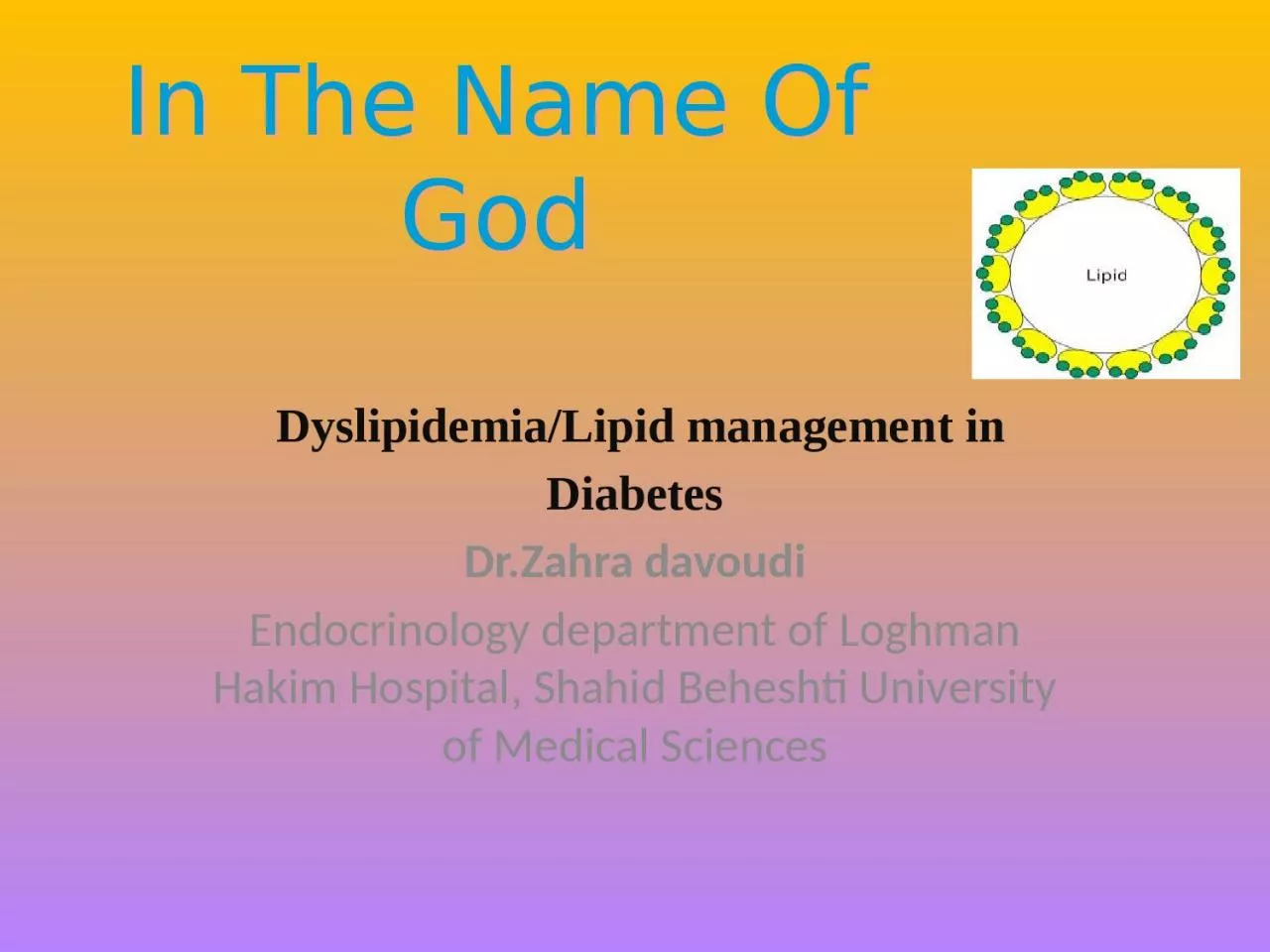

Lipid management in Diabetes DrZahra davoudi Endocrinology department of Loghman Hakim Hospital Shahid Beheshti University of Medical Sciences A 65 yearold woman with medical history of ID: 934344
Download Presentation The PPT/PDF document "In The Name Of God Dyslipidemia" is the property of its rightful owner. Permission is granted to download and print the materials on this web site for personal, non-commercial use only, and to display it on your personal computer provided you do not modify the materials and that you retain all copyright notices contained in the materials. By downloading content from our website, you accept the terms of this agreement.
Slide1
In The Name Of God
Dyslipidemia/Lipid management in DiabetesDr.Zahra davoudiEndocrinology department of Loghman Hakim Hospital, Shahid Beheshti University of Medical Sciences
Slide2A 65 year-old woman with medical history of
Type II diabetes, obesity, and hypertension comes to your office for the first time. She has been told her cholesterol was elevated in the past and states that she has been following a “low cholesterol diet” for the past 6 months after seeing a dietician. She had a normal exercise stress test last year prior to knee replacement surgery and has never had symptoms of CHD. A fasting lipid profile was performed and revealed a LDL 130, HDL 30 and a total triglyceride of 300. Her HbA1c is 6.5%.
Slide3What is this patient’s goal LDL and TG?What medication would you consider starting in this patient?
Slide4CVD
is a major cause of morbidity and mortality in the world. A common cluster of CVD risk factors: Dyslipidemia Hypertension
Hyperglycemia
Insulin resistance
Prothrombotic
state
proinflammatory
state
Obesity
Slide5Hyperlipidemia refers to increased levels of lipids (fats) in the blood, including cholesterol and triglycerides. Although hyperlipidemia does not cause symptoms, it can significantly increase your risk of developing
cardiovascular disease, cerebrovascular disease, and peripheral vascular disease.
Slide6Mechanisms Relating Insulin Resistance and Dyslipidemia
TG
Apo B
VLDL
VLDL
(hepatic
lipase)
Kidney
(CETP)
CE
HDL
TG
Apo A-1
(CETP)
(lipoprotein or hepatic lipase)
SD
LDL
LDL
TG
CE
Fat Cells
Liver
Insulin
IR
X
FFA
6
Slide7The most common pattern of dyslipidemia
is hyperTG and reduced HDLcholesterol levels. DM itself does not increase levels of low-density lipoprotein (LDL), but the small dense LDL particles found in type 2 DM are more atherogenic because they are more easily glycated and susceptible to oxidation.
Slide8Elevated total TG
Reduced HDL-CSmall, dense LDL-C Dyslipidemia in the Insulin Resistance Syndrome
8
Slide9Increased susceptibility to oxidation
Increased vascular permeability Glycation of LDL may be enhanced in diabetes, impairing recognition of the lipoprotein by its hepatoreceptor and extending its half-life.
Small Dense LDL and CHD:
Potential
Atherogenic
Mechanisms
9
Slide10“The Lower, the Better”
Relative
Risk
for CHD (Log Scale)
3.7
2.9
2.2
1.7
1.3
1.0
LDL-C (mg/dL)
40
70
100
130
160
190
0
1
Grundy SM et al.
Circulation
2004;110:227
–
239.
Slide11When to check lipid panel
In most adult patients with diabetes, measure fasting lipid profile at least annually ADAAt the time of diabetes diagnosis, At an initial medical evaluation,
And every 5 years thereafter if under the age of 40 years, or more frequently if indicated
Slide12points
Total cholestrol Nonfasting / Fasting HDL Nonfasting / Fasting
LDL
Friedewald
equation
(LDL-C = (Total cholesterol − HDL-C) − Triglycerides/5)
TG>400 mg/dl –
dysbetalipoproteinemia
*
TG 12-14
hr
Fasting
Slide13Goals of therapy for diabetes mellitus
Eliminate symptoms related to hyperglycemia,Reduce the long-term microvascular and macrovascular complications of DM
Slide14Slide15Lifestyle modification
Lifestyle modification focusing on the reduction of saturated fat, trans fat, and cholesterol intake; increase of n-3 fatty acids, viscous , weight loss (if indicated); and increased physical activityMedicationsTreatment of Hyperlipidemia
Slide1616
Slide17ADA If individuals with diabetes have elevated triglyceride levels >150 mg/
dL or low HDL cholesterol < 40 mg/dL in men and (< 50 mg/dL in women, lifestyle modification and improved glycemic control should be further emphasized
Slide18For most patients with diabetes,
The first priority of dyslipidemia therapy (unless severe hypertriglyceridemia with risk of pancreatitis is the immediate issue) is to lower LDL cholesterol to a target goalTherapy targeting HDL cholesterol or triglycerides lacks the strong evidence base of statin therapy
Slide19Slide20Recommendations for statin and combination treatment in adults with diabetes
†Moderate-intensity statin may be considered based on presence of ASCVD risk factors ASCVD risk factors :::::::::include LDL cholesterol >100 mg/dL ,,,high blood pressure, ,,smoking, chronic kidneydisease, albuminuria, and family history of premature ASCVD.
Slide21High-intensity and moderate-intensity statin therapy
Slide22For patients with DM and CVD,
if LDL cholesterol is> 70 mg/dL on maximally tolerated statin dose, consider adding additional LDL-lowering therapy (such as ezetimibe or PCSK9 inhibitor). A Ezetimibe may be preferred due to lower cost.Statin therapy is contraindicated in pregnancy
Slide23Slide24Slide25Slide26Slide27Slide28Slide29Indication of statin therapy
Diabetic 20-39 yr + diabetic risk enhancer…..moderate statin ( ADA: Age<40 yr + ASCVD risk factors…..moderate statin) ASCVD >20%....high statinDiabetic 40-75 yr=moderate statin (ADA: Age 40–75 yr + ASCVD risk factors….high statin) ASCVD >20%....high statin
Slide30The
evidence is lower for patients aged >75 years; relatively few older patients with diabetes have been enrolled in primary prevention trials. Moderate-intensity statin therapy is recommended in patients with diabetes >75 years or older. However, the risk-benefit profile should be routinely evaluated in this population, with downward titration of dose performed as needed.
Slide31HypertriglyceridemiaHypertriglyceridemia
should be addressed with dietary and lifestyle changes (obesity and metabolic syndrome), secondary factors (diabetes, chronic liver or kidney disease and/or nephrotic syndrome, hypothyroidism), and medications Severe hypertriglyceridemia (fastingTG>500 mg/dL and especially >1000 mg/dL) may warrant pharmacologic therapy (fibric acid derivatives and/or fish oil) to reduce the risk of acute pancreatitis. In addition, if 10-year ASCVD risk is 7.5%, it is reasonable to initiate moderate-intensity statin therapy or increase statin intensity from moderate to high. In patients with moderate hypertriglyceridemia (>150- <500 ), lifestyle interventions, treatment of secondary factors, and avoidance of medications that might raise triglycerides are recommended.
Slide32The Major Approved Drugs Used for the Treatment of Dyslipidemia
Slide33The Major Approved Drugs Used for the Treatment of Dyslipidemia
Slide34The Major Approved Drugs Used for the Treatment of Dyslipidemia
Slide35Thanks for your attention